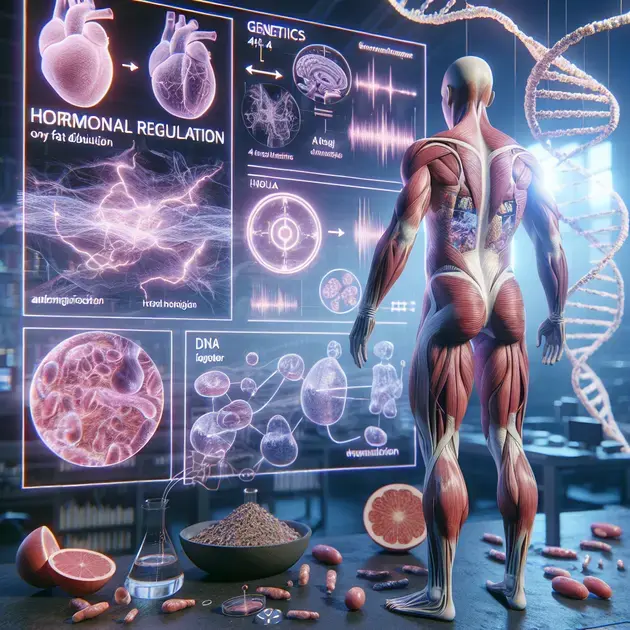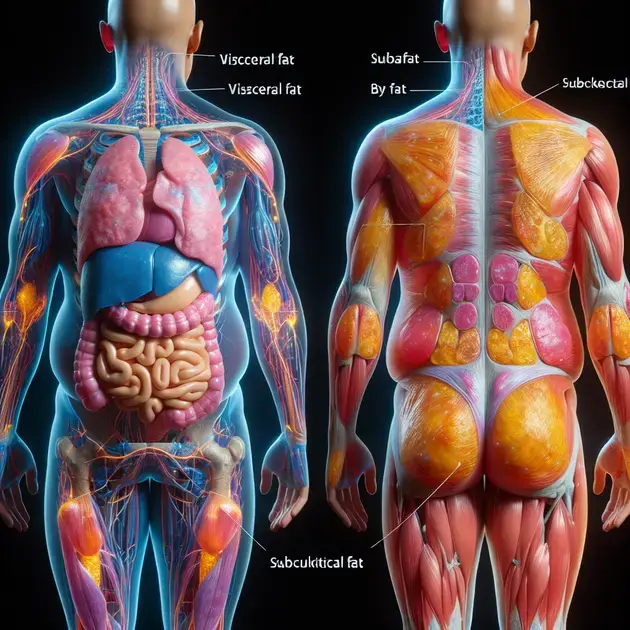When it comes to our health, understanding the truth about body fat is crucial. With so much information available online, it’s important to separate fact from fiction to make informed decisions about our well-being.
Recent studies have shown that not all body fat is created equal. While too much visceral fat can increase the risk of various health conditions, subcutaneous fat may have some protective effects on the body.

Understanding the Different Types of Body Fat
Body fat is classified into two main types: visceral fat and subcutaneous fat. Understanding the differences between these two types of fat is crucial for overall health and well-being.
Step 1: To differentiate between visceral and subcutaneous fat, you can use various body composition analysis tools. One popular method is using the DEXA scan, which provides detailed insights into the distribution of fat in the body. You can schedule a DEXA scan appointment at a local clinic or health facility.
Step 2: Another way to understand body fat types is through bioelectrical impedance analysis (BIA). This method uses a specialized scale or handheld device to measure body fat percentage and distinguish between visceral and subcutaneous fat. You can find BIA devices at fitness centers or purchase them online from reputable retailers.
Step 3: It’s also beneficial to track your body fat changes over time using fitness apps like MyFitnessPal or Fitbit. These apps can provide personalized recommendations based on your body composition goals and help you monitor the effects of diet and exercise on visceral and subcutaneous fat levels.
Step 4: Understanding the different types of body fat can also involve consulting with a healthcare professional or registered dietitian. They can offer personalized advice and create a customized plan to target specific areas of fat accumulation in your body.
Step 5: Educating yourself about body fat distribution and its impact on health can empower you to make informed decisions about your lifestyle habits. By incorporating healthy eating habits, regular physical activity, and targeted exercises, you can effectively manage and reduce both visceral and subcutaneous fat levels.
The Impact of Visceral Fat on Health
Visceral fat, also known as belly fat, is stored around the abdominal cavity and poses significant health risks when accumulated in excess. Understanding the impact of visceral fat on health is essential for disease prevention and overall well-being.
Step 1: One way to assess the impact of visceral fat on health is through waist circumference measurements. Using a flexible tape measure, wrap it around your waist at the level of your belly button. High waist circumference indicates an increased risk of visceral fat accumulation and related health issues.
Step 2: Health monitoring devices like smart scales with body composition analysis features can provide insights into visceral fat levels. Brands like Withings and Tanita offer smart scales that can measure visceral fat percentage and track changes over time.
Step 3: Educational resources from reputable health websites like WebMD or Mayo Clinic can further enlighten you on the adverse effects of excess visceral fat. These platforms offer articles, videos, and infographics that explain the link between visceral fat and conditions such as heart disease, type 2 diabetes, and metabolic syndrome.
Step 4: Regular cardiovascular exercise, such as running or swimming, can effectively reduce visceral fat levels and improve overall health. Fitness apps like Nike Training Club or Strava provide guided workouts and training plans specifically designed to target visceral fat burning.
Step 5: Consultation with a healthcare provider or a fitness trainer can offer personalized recommendations to combat visceral fat accumulation. They can create a tailored exercise routine and dietary plan to help reduce visceral fat and lower the associated health risks.
Uncovering the Truth About Subcutaneous Fat
Subcutaneous fat is the fat layer beneath the skin that acts as insulation and energy storage. Demystifying the truth about subcutaneous fat can provide insights into its role in the body and how it differs from visceral fat.
Step 1: Research studies published in scientific journals like the Journal of Clinical Endocrinology & Metabolism or the Journal of Lipid Research offer valuable information on subcutaneous fat physiology and metabolism. Access these journals through platforms like PubMed or ResearchGate.
Step 2: By using body fat calipers, you can measure skinfold thickness at different sites on the body to estimate subcutaneous fat levels. These calipers are available for purchase online from fitness equipment retailers or specialty stores.
Step 3: Health and wellness podcasts like “FoundMyFitness” by Dr. Rhonda Patrick or “The Model Health Show” by Shawn Stevenson often feature episodes that delve into the science behind subcutaneous fat and its impact on health. Tune in to these podcasts for expert insights and practical tips.
Step 4: Tracking your subcutaneous fat changes can be done through body fat tracking apps such as FatSecret or BodyFast. These apps allow you to input your measurements, monitor progress, and receive feedback on how lifestyle choices influence subcutaneous fat levels.
Step 5: Understanding the truth about subcutaneous fat involves recognizing its essential role in the body’s energy balance and overall health. By maintaining a healthy body fat percentage through balanced nutrition and regular exercise, you can optimize subcutaneous fat levels and support your well-being.

Examining the Relationship Between Hormones and Body Fat
Hormones play a crucial role in the regulation of body fat storage and distribution. One key hormone in this process is insulin, which is responsible for transporting glucose from the bloodstream into cells to be used as energy or stored as fat. When insulin levels are high, the body is more likely to store excess energy as fat, especially around the abdomen. This can lead to an increased risk of obesity and related health issues.
Another important hormone related to body fat is leptin, often referred to as the satiety hormone. Leptin helps regulate appetite and energy balance by signaling to the brain when the body has had enough to eat. However, in cases of leptin resistance, this signaling process is disrupted, leading to overeating and weight gain. Understanding the interactions between insulin, leptin, and other hormones can provide valuable insights into the mechanisms behind body fat accumulation.
Cortisol, known as the stress hormone, can also impact body fat distribution. High levels of cortisol, often associated with chronic stress, have been linked to increased visceral fat storage. Visceral fat, found deep within the abdomen surrounding vital organs, is more metabolically active and poses greater health risks than subcutaneous fat. Managing stress levels through lifestyle changes and stress-reducing activities may help prevent excessive cortisol production and its effects on body fat.
In conclusion, the relationship between hormones and body fat is complex and multifaceted. By examining how different hormones influence fat storage and distribution, researchers and health professionals can develop targeted strategies to address obesity and promote overall health and well-being.
Dispelling Common Myths About Body Fat Distribution
There are several common myths surrounding body fat distribution that can contribute to misunderstandings about weight management. One prevalent myth is that targeting specific exercises, such as crunches or side bends, can spot reduce fat in certain areas of the body. In reality, spot reduction is a myth, and fat loss occurs systematically throughout the body rather than in targeted areas.
Another myth is that body fat distribution is solely determined by genetics and cannot be influenced by lifestyle factors. While genetics do play a role in where fat is stored, lifestyle choices such as diet, exercise, and sleep habits can also significantly impact body fat distribution. Adopting a healthy lifestyle can help optimize fat distribution and overall body composition.
It is also commonly believed that individuals with a higher body mass index (BMI) are always unhealthy, while those with a lower BMI are inherently healthier. However, BMI is a basic measure of body weight relative to height and does not account for factors such as muscle mass or body fat percentage. It is essential to consider a range of health indicators beyond BMI to assess overall health and well-being.
By dispelling these myths and promoting a holistic understanding of body fat distribution, individuals can make informed decisions about their health and fitness goals. Emphasizing the importance of overall lifestyle factors and body composition can lead to more sustainable and effective strategies for managing body fat.
The Role of Genetics in Determining Body Fat Percentage
Genetics play a significant role in determining an individual’s body fat percentage and distribution. Certain genetic factors can influence how and where fat is stored in the body, impacting an individual’s overall body composition. For example, some people may have a genetic predisposition to store more fat in the abdominal area, while others may store fat more evenly throughout their bodies.
Studies have identified specific genes that are associated with body fat percentage and obesity risk. These genes can affect various aspects of metabolism, appetite regulation, and fat storage mechanisms. Understanding these genetic influences can provide valuable insights into personalized approaches to weight management and obesity prevention.
While genetics can influence body fat percentage, lifestyle factors also play a crucial role in determining overall body composition. Factors such as diet, physical activity, and stress management can interact with genetic predispositions to affect body fat levels. By adopting healthy lifestyle habits and addressing genetic predispositions, individuals can optimize their body fat percentage and improve their overall health.
It is essential to recognize that genetics are not the sole determinants of body fat percentage and that lifestyle choices can significantly impact body composition. By acknowledging the interplay between genetics and lifestyle factors, individuals can take a proactive approach to managing their body fat percentage and promoting long-term health and well-being.
**
Conclusion
**
The intricate relationship between hormones and body fat reveals a complex interplay crucial for understanding fat storage and distribution. Insulin, a key hormone, governs the storage of energy as fat, particularly in the abdomen when its levels are elevated. This dynamic process highlights the risk of obesity and associated health complications linked to excessive fat accumulation.
Leptin, known as the satiety hormone, acts as a regulator of appetite and energy balance, signaling to the brain when satiety is reached. However, disruptions like leptin resistance can lead to overeating and weight gain. Exploring the interactions of insulin, leptin, and other hormones offers valuable insights into the mechanisms underlying fat accumulation.
Moreover, cortisol, the stress hormone, influences body fat distribution, particularly visceral fat accumulation associated with chronic stress. This type of fat poses heightened health risks and managing stress levels through lifestyle modifications can aid in curbing excessive cortisol production and its impact on body fat storage. By delving into these hormone-driven intricacies, researchers and healthcare providers can develop tailored strategies to combat obesity and enhance overall well-being.